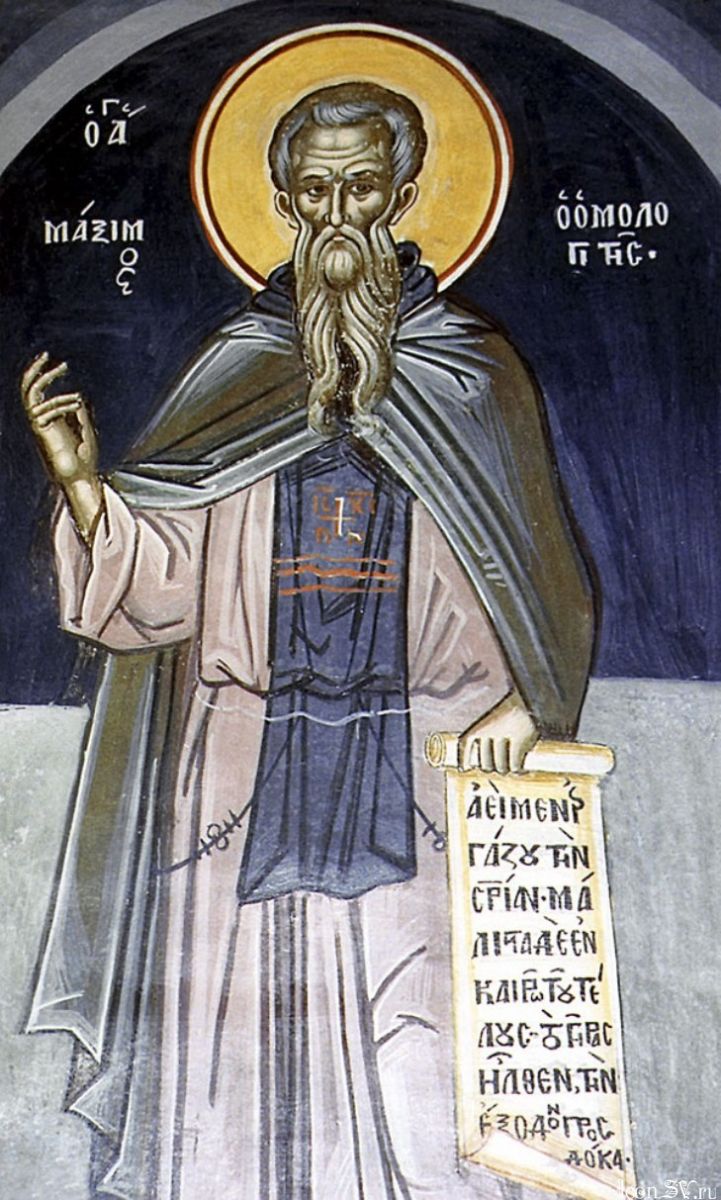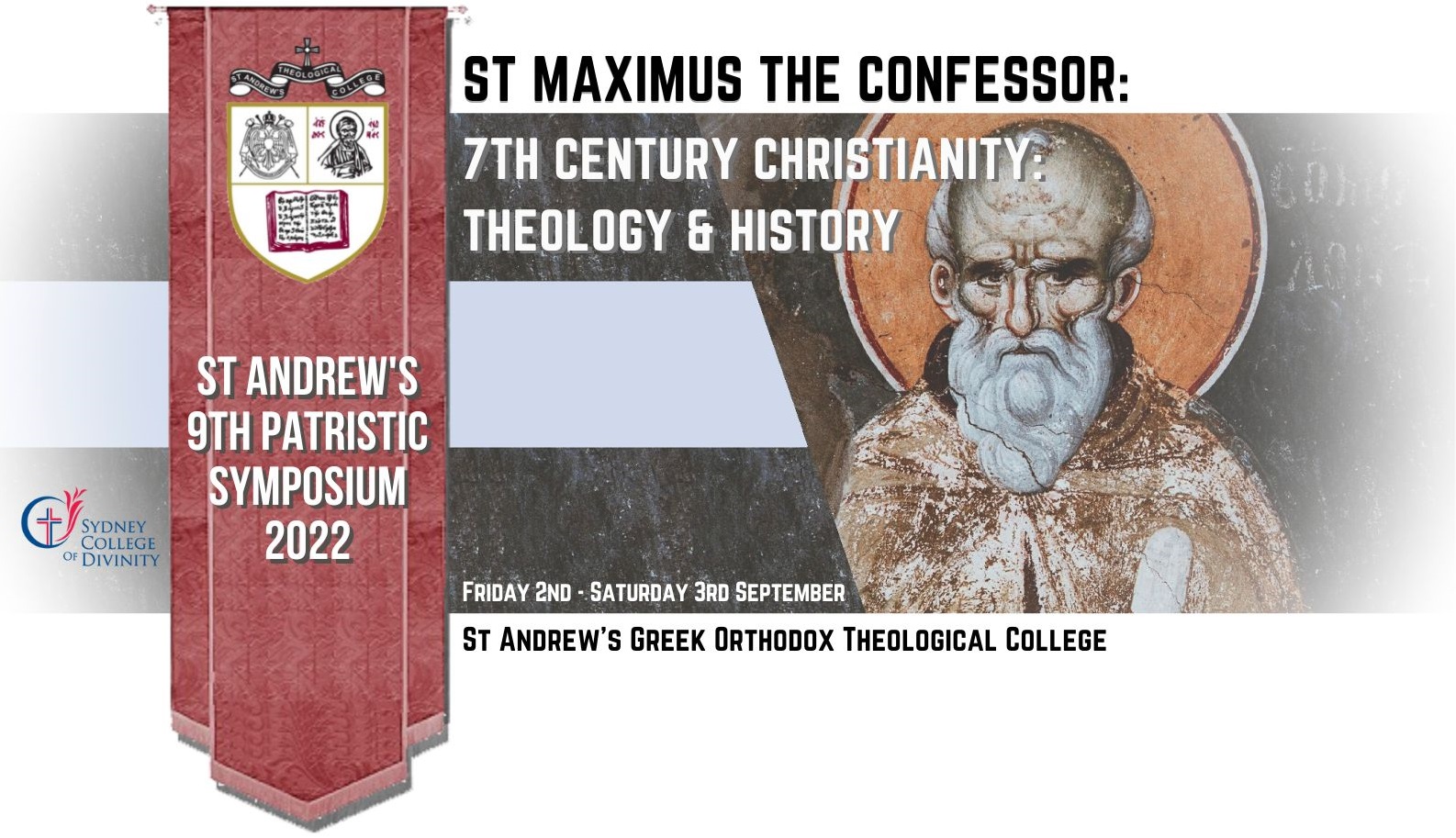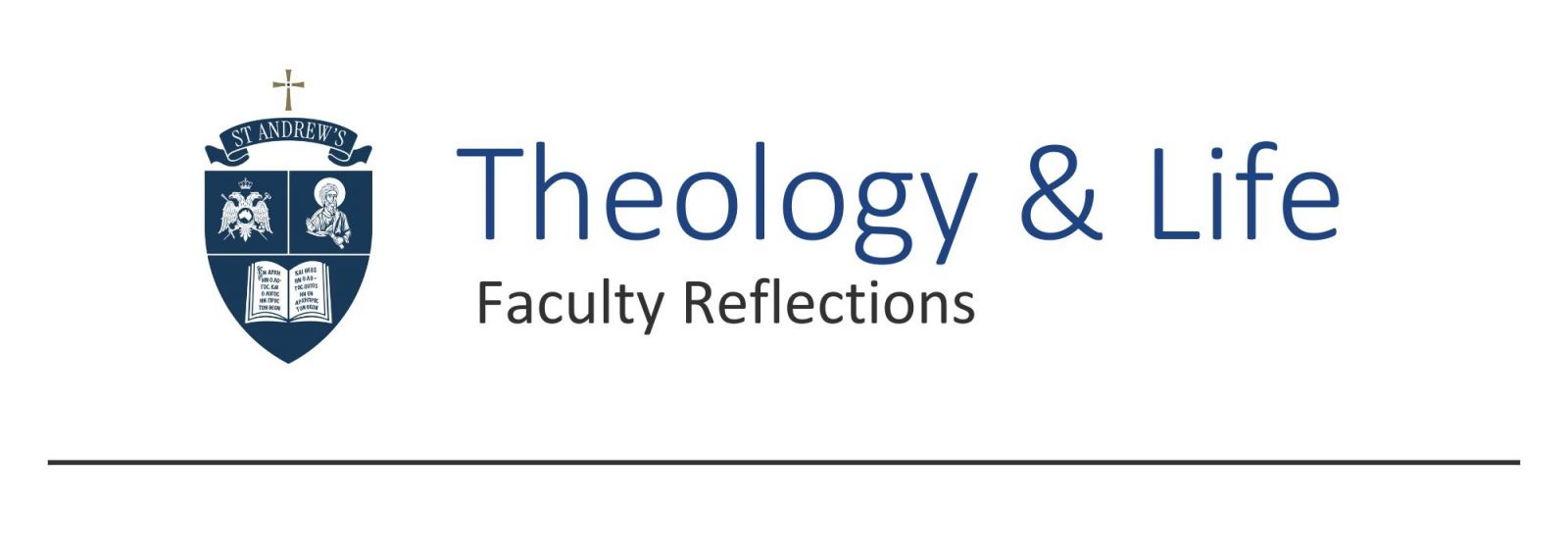-
Fifteen speakers presented their research papers.
-
We are overjoyed by the diversity and richness of the respective presentations and the variety of topics in Christology explored
-
Select papers from this Symposium are scheduled to be published as peer reviewed articles in St Andrew's Academic Journal Phronema in the second semester of 2023.
Dr Vasilis Adrahtas
Western Sydney University and University of NSW
St Maximus the Confessor at the Intersection of Hellenic Philosophy, Jewish Mysticism and Early Islamic Thought
Abstract: The historical contextualisation of St Maximus the Confessor yields some quite intriguing details. More specifically, he was born just 10-20 years after the last pagan philosophers (Simplicius and Olympiodorus); his lifespan lies right in the middle of the historical development of the type of Jewish mysticism known as Merkabah and Hekhalot literature; and lastly, he was roughly a contemporary of Muhammad (about 10 years younger than the Rasul of Islam), while his end coincides with the end of the Rasidun period. The critical question that arises here is the following: does this contextualisation have any concrete and specific relevance to the work of St Maximus? The present paper aspires to provide an answer to this question by exploring the oeuvre of St Maximus the Confessor from a broader History of Religions perspective. In particular, it treats the aforementioned contextualisation as a working hypothesis and investigates both the hierophanic and the rationalist Neoplatonic traditions, the claims of the so-called ‘Theophaneia School’ regarding the origins of Christian mysticism, as well as the early protest Islamic movement of the Kharijites. In other words, the paper argues that the hypothesis that the thought of St Maximus the Confessor can be fully appreciated if seen at a multi-religious intersection can be sustained. St Maximus’ Scholia on the Corpus Areopagiticum and his work on various philosophical topics (terms, definitions, syllogisms, etc.) are approached with regards to his Neoplatonic influences. His Mystagogia, as well as a range of his ascetical Chapters, are put forward as prime examples of his mystical theology vis-à-vis Jewish mysticism. And, lastly, the Kharijites and their emphasis on personal agency and the importance of internal volition are brought into the discussion in order to show that they were part of a broader interest of the times, which was manifested magisterially in the dogmatic works of St Maximus.
Sr Assoc. Prof. Margaret Beirne
St Andrew’s Theological College, Sydney College of Divinity
Christoph Schönborn: Pleasure and Pain according to Quaestiones ad Thalassium
Abstract: In 1980, from 2 to 5 September, a Symposium on St Maximus was held in Swiss Fribourg. It was an ecumenical gathering of scholars to share their research and their appreciation of the contribution of St Maximus to the Christian Churches. Just over forty years later, we have come together at St Andrew’s these two days, for a strikingly similar purpose. Papers given at that previous gathering were published in the language of the presenter, half of them in French, only four in English, under the title: Maximus Confessor. Actes du Symposium sur Maxime le Confesseur, Fribourg, 2-5 septembre 1980 (Felix Heinzer & Christoph Schönborn eds., Fribourg Suisse: Ếditions Universitaires, 1982). One of the articles in French is by the co-editor and patristics scholar, Christoph Schönborn. As it has not previously been published in English, I shall introduce it and provide a translation. The English title is “Pleasure and Pain in the Analysis of St Maximus, according to Questiones ad Thalassium”.
Professor David Bradshaw
University of Kentucky
St Maximus vs Monoenergism: The Natural Energies
Abstract: One of St. Maximus's most enduring legacies is the concept of natural energy. This is not quite an energeia in the normal sense—that is, an activity or characteristic pattern of action. It is instead a capacity for action of the sort that is characteristic of the nature in question. Maximus defines the natural energy as a “natural, constitutive power . . . which is properly and primarily characteristic of the nature, since it is the most generic motion constitutive of the species.” Remarkably, the natural energy is characterized here as both a power (dunamis) and a motion (kinēsis). This paper will seek to unfold the meaning of this definition by tracing the prior development of the concept of natural energy and its explication by Maximus.
Assoc. Prof. Adam Cooper
University of Divinity, Catholic Theological College
Maximus and the Symbolism of Numbers
Abstract: Among Maximus’s more formidable hermeneutical tools is his theology of arithmetic, or number symbolism. While a typical feature in the Greek exegetical tradition, number symbolism finds more profound and detailed expression in Maximus’s writings. To the modern reader, many of his proposals seem weird and contrived. Examination of his use of arithmetical theology provokes a number of questions. Are Maximus’s number tricks just a pretext for demonstrating what he already knows, a confirmation and elaborate demonstration of ascetic, spiritual, and dogmatic facts he knows by other means? Or does he through studying numbers and speculating about their meaning and use discover something really new? Certainly the Confessor’s exercises with numbers say something about his view of Scripture. Every detail has a God-given meaning and a purpose. Paying close attention to these details, with a view to discerning their deeper sense, is meant to enable the reader’s progress in virtue and gradual comprehension of saving and divine mysteries. By doing the requisite arithmetical research, and speculating on possible interpretations of what the various numbers signify, Maximus is hoping to provide his monastic colleagues and students with material to do their own ‘soul-work’, to reflect on what he offers and apply it to their own lives as they think best and as the Holy Spirit gives them insight.
Michael Ibrahim
St Cyril’s Coptic Orthodox Theological College
A Saint and a Physicist Walk into a Bar: St Maximus the Confessor and David Bohm in Dialogue
Abstract: The post-Cartesian world can be characterised as one of phenomenological disentanglement. The isolation of variables paved the way for dramatic advances in science, but also resulted in a retreat of ‘metaphysics’ from public discourse. Despite this, an unexpected rebellion has taken place within the hard sciences. From ecology and genetics to cosmology and mathematical chaos theory, a new vision of reality emerged, namely that of an entangled and interdependent cosmos. One of the most prominent revolutions to take place was within the discipline of physics. Quantum mechanics is undoubtedly the atomic equivalent of the Copernican revolution, with wave-particle duality, Heisenberg’s uncertainly principle and quantum entanglement directly challenging our sense-perception. As it stands, standard quantum theory appears to point to a fundamental ‘apophatic’ dimension to reality, with Newtonian certainty replaced by probabilistic distributions. One alternative approach to quantum phenomena was the de Broglie/Bohm pilot wave theory. This theory provided a bridge between classical Newtonian mechanics and quantum phenomena, by proposing a pilot wave which impacted particle trajectories in such a way as to account for the seemingly wave-like and probabilistic behaviour. This concept was further developed by Bohm into a philosophical system, where physical phenomena were an explicate experience of a unified and implicate universal order. Remarkably, this system derived from quantum mechanics appears to echo early Christian/Stoic Logocentric cosmologies, as exemplified by the thought of St Maximus the Confessor. Of particular interest is the anthropological consequences of this cosmology. As such, this paper will explore the conceptual resonances between these two remarkable thinkers by bringing their respective cosmologies into ‘dialogue’.
Dr Cullan Joyce
University of Divinity, Catholic Theological College
What can historical contemplative traditions contribute to Contemplative Research?
Modelling Maximus the Confessor’s Contemplative Practice.
Abstract: Contemplative Research examines the context, characteristics, and effects of meditative practices. The exemplar of the research is mindfulness. Mindfulness meditation emerged from Buddhist traditions but, arguably, for various reasons, the research pared the meditative practices down to simple cognitive processes and investigated how minimal dosages produce benefits. Overall, the practice is of modest benefit when offered in structured programs. Recent work on Christian practices criticised elements of the mindfulness research model but applied the model to practice traditions such as Centering Prayer and John Main’s Christian meditation. Research in historical traditions is contributing to contemplative research by identifying how cognitive processes such as attention (melete - μελέτη), function in Evagrius and others. This paper undertakes a similar approach using Maximus the Confessor’s Centuries on Love. Maximus’ writings contain cognitive behaviours that both are standard to, and vary from, a mindfulness model. The paper surveys recent secondary literature then examines Maximus’ texts for behaviours such as sustained observation (melete-μελέτη) undistracted attention (aperiskopos-ἀπερίσκοπος), close examination (prosucheia- προσέχεια) and other contexts, including the experience of demons and God, to create a model of meditation. When these behaviours are applied in various contexts, they affect the meditator’s experience. Abstracting from the behaviours and experiences of demons and God, the paper proposes a model of meditation in Maximus as a practice of sustained and progressive receptivity. The paper concludes with comments on how we might adopt these emphases in Maximus’ work. This final query uses a standard model for contemplative research where a practice is organised into different practice durations and practice types and the outcomes of these varied practices are measured in various ways.
A/Prof. Eva Anagnostou-Laoutides, Kyeongyoon Woo
Macquarie University
The Bacchic State of Mind and Maximus’ Christian Citizenship
Abstract: The problem of determining the true Bacchoi, the genuine students of philosophy who have the courage to ignore the interference of bodily desires in exchange for the truth, has been decidedly introduced by Plato in his Phaedo (69c). Plato also discussed the Bacchic constitution of the philosopher in the Symposium and famously the Phaedrus, while he also advocated the civic benefits of wine by boldly suggesting the Test of the Wine in the Laws (649d11-e1) as a cheap yet effective tool of training the citizens of Magnesia. Here I wish to examine the Platonic baccheia as a model for Maximus’ Mystagogy where the eucharist is celebrated as the pinnacle of Christian liturgical life through which Christians confirm not only their participation in their contemporary community but also the Heavenly kingdom. Although Maximus’ Neoplatonic influences are typically examined in connection with Origen, pseudo-Dionysius, and (through him) Proclus, here I wish to examine two figures less discussed as Maximus’ models, namely Clement of Alexandria and pseudo-Macarius. For Clement, a dedicated reader of Plato, the Bacchic experience of God prepares Christian minds and souls for a new mode of participation in the Heavenly kingdom, a new form of citizenship, here and ever. Clement’s early musings have a notable, though little discussed impact on pseudo-Macarius, writing in the fourth-century. Pseudo-Macarius’ appreciation of ecstatic drunkenness as a metaphor of spiritual progress and symbol of our successful claim of citizenship in God is highly relevant for the ascetic model of life that he advocates, and the notion of community that Christians should aspire to. The paper examines the circumstances in which Clement and pseudo-Macarius contribute to Maximus’ thought the practical aspects that Proclus’ Neoplatonic theurgy, Christianized by pseudo-Dionysius, could not.
Dr Andrew Mellas
St Andrew’s Theological College, Sydney College of Divinity
“The Silence Abounding in Song”: Eschatology and Emotion in St Maximus the Confessor’s Mystagogia
Abstract: St Maximus the Confessor’s polytemporal vision of liturgical life in Byzantium was eschatological yet embodied. The performance of the liturgy in the habitus of sacred space enacted the eschaton, collapsing past, present and future into liturgical time. While the beginning of the liturgy signified the birth of Christ and the Little Entrance his crucifixion, resurrection and ascension, the proclamation of the Gospel marked the end of history and all that followed took place in the age to come. Maximus’ On Ecclesiastical Mystagogy is eschatological and allegorical in its approach to liturgy, but this reading is intertwined with the liturgical world of Byzantium, which was a prism of materiality, processions and sounds. Beyond the aesthetic wonder these phenomena aroused, they could also engender liturgical emotions, inviting the faithful to feel beyond their nature. For Maximus, the transformation of human emotion into divine emotion occurs not simply through asceticism but within the liturgical universe the faithful experienced. My paper will explore the relationships between liturgy and hymnody in Maximus’ commentary, and how these modalities became a mystagogical experience where heaven and earth converged amid sacred spaces, but also in the hearts of the faithful.
Revd Dr Joe Mock
Gracepoint Chinese Presbyterian Church
To what extent did the Christology of Bullinger mirror the Christology of Maximus the Confessor?
Abstract: The Swiss reformer Heinrich Bullinger (1504-1575) often cited the Church Fathers in order to demonstrate to Rome, in particular, that the Zurich reformers were both faithful to Scripture and the faith of the Early Church. The ubiquity of Christ’s body in connection with the Lord’s Supper underlined the radical differences between Zurich and Wittenberg concerning the two natures in Christ and the nature of salvation itself. Significantly, one of Bullinger’s earliest works was Utriusque in Christo naturae (1539) which focused on the two natures in Christ. Throughout the years of his ministry Bullinger often wrote on christological themes. The Decades (1549-1551) has a section on Christology that reflected the contemporary debates Bullinger was engaged in. This material was reiterated or expanded in several catechisms. In response to attacks by Johannes Brenz (1499-1570) Bullinger penned Fundamentum firmum (1563) which emphasized several aspects of Christology. Maximus’ Christology in his Ambigua demonstrated the convergence of apophatic and cataphatic theology. Inter alia, he discussed perichoresis with respect to the three persons of the Trinity, the nature of the incarnation, the two natures in Christ, the sinlessness of Christ, communicatio idiomatum and dyothelitism. Moreover, Maximus wrote concerning recapitulation and considered what it means to be human in light of the incarnation as well as theosis. In his works, Bullinger does not appear to directly cite Maximus although two volumes of Maximus’ works were in the private library of Zwingli. He does cite Cyril of Alexandria. Nonetheless, it can be demonstrated that there are many points of contact between the Christology of Bullinger and that of Maximus.
Revd Assoc. Prof. Bassam Nassif
St John of Damascus Institute of Theology (Balamand University)
Divine Beauty of Humanity: Saint Maximus’ Perspective of Gender and the Experience of Saints
Abstract: Much has been written about Ambiguum 41 and Saint Maximus the Confessor’s perspective on gender. This research revisits this Ambiguum, showing how Saint Maximus’s perspective is a Christian patristic synthesis on gender, interpreted and applied in Christian living. His perspective opens the eye to understand saintly models that have reflected throughout the centuries the beauty of God’s image, being male or female, and in marriage or in celibacy. The epiclesis of the Holy Spirit, in fervent harmony with humanity, continues to transfigure both man and woman, rendering them earthly angels, without losing their natural gender identity. In conclusion, this study reveals how all this Divine economy opens the way for humanity to a great mystery: the mystical marriage with Christ.
Prof. Aristotle Papanikolaou
Fordham University, Co-Director of the Orthodox Christian Studies Centre
St Maximus, the Virtues, and the Architecture of the Soul
Abstract: This paper will discuss St. Maximus the Confessor’s understanding of what theosis looks like, which he describes in terms of the relation between the manifestation of the virtues and the architecture of the soul. For St. Maximus, the virtue of virtues is love, which St. Maximus describes both in terms of eros and agape. Virtues are specific to and shape the various parts of the soul—affective and rational—so they can work together in order to provide the conditions for the possibility the realization of well-being, which St. Maximus defines in terms of wisdom and goodness. Theosis as union with God is true knowledge of God, but there can be no knowledge of God and God’s intentions (logoi) in creation through contemplation without the formation of the will to love God and to love all things in God. In union with God, the rational capacity ceases functioning as it is saturated with the divine light and all that remains is an infinite eros for God. This union is the culmination of ascetical practices whose goal is the manifestation of the virtues.
James Rutherford
Moore Theological College
The Use of the Divine-Human Analogy in the Niceno-Chalcedonian Tradition and Maximus the Confessor
Abstract: A significant feature of the conciliar tradition up to the Council of Chalcedon was the use of ontological concepts and terminology developed with reference to humanity to explain the unity and plurality of the Trinity. The use of this analogy is embedded in the Definition of Chalcedon with its declaration of the dual consubstantiality of Christ. Over a century later, Maximus the Confessor continues to employ this analogy across his account of the incarnation, yet he is forced to break it off when applied to the Trinity, lest a heretical position obtain. The apparently arbitrary cessation of this analogy at the very point where it causes problems sheds light on an aporia several authors have identified at Chalcedon. Namely, the ontological apparatus developed to account for the divine and human in Christ Jesus cannot be consistently applied to the Trinity without error resulting, yet the logic of the conciliar tradition as it culminates in the Definition of Chalcedon invites us to do this very thing.
Dr Nikolaos Zarotiadis
Aristotle University of Thessaloniki
Learning to love: Approaching the teaching of St. Cyprian and St. Maximus the Confessor
Abstract: The purpose of this lecture is to present the teaching of two great Fathers of the Church, Saint Cyprian and Saint Maximus the Confessor, on the virtue of love for the neighbor and to identify common points in their writings. At many points in his works, St Cyprian mentions and elaborates onthe unfathomable value of loving one’s neighbour. Especially, in his treatise De opere et eleemosynis, in an advisory and exhortative style, he presents those ways through which the faithful Christian can achieve heavenly salvation by helping his neighbour morally, spiritually and materially. It is more than obvious that love, faith and alms are presented by Cyprian as the best way for man to purify sins. On the other hand, when Saint Maximus the Confessor refers to love of neighbour in his treatise The four Centuries on Charity (Κεφάλαιαπερίαγάπης), he is actually referring to love of God. God is the One who is to be loved for the benefit of all people. Love of neighbour must be sincere, just as love of God must be sincere. In other words, he considers the human person’s love to God as the only essential presupposition of someone being able to truly loving his neighbour. Conclusively, we realise that both saints, Cyprian and Maximus point out clearly that within true love for the neighbour, the love for Christ is more than present, because Christ Himself is the source oflove. In his writings, St Cyprian approaches love of neighbor as a daily struggle, through which the faithful Christian must actively and practicallyassist his helpless brother with alms and charity. By denying material possessions and giving awaythe riches of the world he secures heavenly treasures (celestes thesauros). On the other hand, St Maximus relates to the teaching of St Cyprian in emphasizing that love of one's fellow man is love of God, but he examines the virtue of love by demonstratingits four aspects: universality, equality, theocentricity and the sacrificial spirit for the sake of the other.












.jpg)





.png)